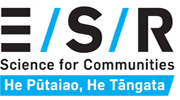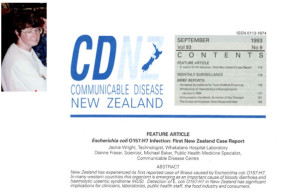30th Anniversary of STEC discovery in Aotearoa
There’s nothing like the start of the barbecue season to bring to mind E. coli.
But when ESR microbiologist Jackie Wright made the first case report of Escherichia coli O157:H7 in Aotearoa New Zealand in 1993 – along with collaborators Dianne Fraser and Michael Baker – she wasn’t aware just how much she was making history.
This year ESR is celebrating the thirtieth anniversary of the discovery of Shiga-toxin producing E. coli (STEC) in Aotearoa, and Jackie’s contribution to public health and food safety.
E coli O157:H7 causes illness in humans by producing powerful Shiga toxin, which can damage the intestinal lining. The E. coli strains that make Shiga toxin are also called Shiga toxin-producing E. coli, or STEC. STEC infection is a significant foodborne disease, and in 2022, the number of cases reported in New Zealand trumped other well-known diseases like salmonellosis and listeriosis.
In her recent seminar presentation “Clinical STEC in Aotearoa New Zealand,” Jackie says that she chose to include E. coli O157:H7 in the research survey “at the last minute,” because of the recent Jack in the Box outbreak caused by this bacterium, which was linked to undercooked mince patties sold by the fast-food chain in the United States.
Professor Michael Baker, epidemiologist and public health physician at the University of Otago, says of the discovery: “Recognising the presence of E. coli O157 for the first time in Aotearoa New Zealand was a major milestone for enteric disease surveillance in this country. This discovery was a tribute to Jackie’s initiative and high level of laboratory expertise.”
Jackie herself is more self-effacing about the discovery, saying: “We all know in microbiology, if you look, you find. This isn’t a case of being in the right place when STEC O157 just happened to appear, if someone had looked before, they would have found it.”
Nevertheless, after this first discovery of STEC O157 in Aotearoa New Zealand, more people started looking for it, which set the wheels in motion for the robust national STEC surveillance we now have. “In the subsequent 30 years, this pathogen has emerged as an important cause of severe enteric infection across the globe. It is also a hazard that requires close control by our meat export sector,” says Michael.
Jackie herself has remained a constant in this space over the last three decades. While she left ESR in the late 1990s, she continued to work on enteric pathogen detection in the commercial food sector and then moved into human diagnostic microbiology. Then Jackie worked for 12 years in a small community laboratory, before returning to ESR in 2017 to lead the Enteric Reference Laboratory team.
The STEC surveillance data analysed by ESR’s Enteric Reference Laboratory team is essential to understanding the epidemiology of the pathogen including prevalence, circulating strains, and disease severity. The work is also critical to identifying and investigating outbreaks.
On the legacy of Jackie’s discovery, Michael says: “Jackie should be very proud of her lasting contribution to protecting public health in Aotearoa New Zealand. It was a pleasure to work with her during my time at ESR.”
And for all of us, we can appreciate having a better understanding of food safety during this upcoming season of picnics and potlucks.

